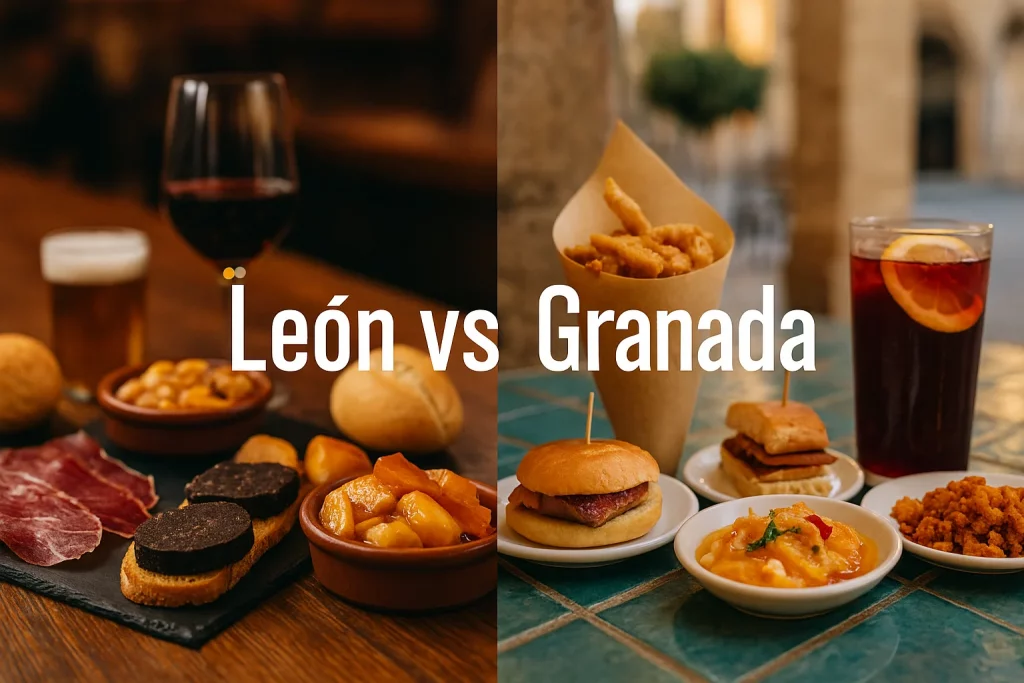Choosing between León and Granada for a tapas route is like picking between two “top leagues.” Both cities keep the tradition of a complimentary tapa with your drink alive, though with different styles and rhythms. Here’s a clear comparison to help you decide based on your taste, budget, and how you like to enjoy the street scene.

1) How does the tapa-with-drink work?
In León, it’s standard to get a tapa included with your wine or small beer; in the Húmedo and Romántico districts it’s almost a ritual. The rotation of tapas is quick and varied—ranging from spoon dishes to cured meats and hot bites—and many bars let you choose from two or three daily options. It’s a dynamic experience: bars sit just metres apart and you “hop” without watching the clock.
It’s also common for your second drink to come with a different tapa, so in three or four stops you’ll have sampled a very complete mini-menu. If you’re travelling as a group, order drinks in pairs so the kitchen sends out different tapas you can share.
In Granada, the free tapa is a hallmark too, but with a twist: in many bars portions are more generous and sometimes there’s a set “sequence” by rounds (1st, 2nd, 3rd), which changes or improves with each drink. It’s common for the bar to choose the tapa for you—though many accept suggestions—turning the route into a small “guided tasting.”
A useful tip: if you have dietary preferences (vegetarian, gluten-free, no pork), mention it from the first round; Granada usually has alternatives. And if you fall in love with a specific tapa, ask for the full ration: it’s almost always on the menu.
2) Where and how to go for tapas (neighbourhoods and pace)
León concentrates the action in its pedestrianised old town: Plaza de San Martín and surroundings (Húmedo) and the Romántico, linked by short streets and squares that invite repeat visits. Because bars are so close, you can try several in an hour without getting tired; it’s perfect for groups and for those who enjoy comparing specialties.
Peak times are 13:00–16:00 and 20:00–23:30 (later on Fridays and Saturdays). On weekdays there’s a strong university vibe; during local festivals (San Juan y San Pedro, San Froilán) the centre is a party—arrive with time to spare.
Granada spreads its stops across areas like Calle Navas, Realejo, Plaza Nueva, and the Albaicín. It’s also very walkable, though hops between neighbourhoods can be a bit longer. It’s a city with a marked student atmosphere: terraces and outdoor living stretch the tapas plan into long after-lunch sessions, especially in good weather.
If you’re heading up to the Albaicín or the Mirador de San Nicolás between rounds, wear comfortable shoes: the hills and cobbles are part of the charm—and the exercise that builds up an appetite.
3) Typical flavours and local produce
In León, local products and Castilian-Leonese recipes take the lead: PGI cecina (cured beef), León morcilla (blood sausage), chorizo, picadillo, mini “cachopos” in the León style, legume stews (La Bañeza beans), soups, and tender omelettes. Creative touches and quality breads are increasingly common, without losing the hearty profile that suits the northern climate. For toasting, look to DO León (Prieto Picudo) and El Bierzo (Mencía).
Those seeking lighter or veggie options will find omelettes, roasted peppers, mushrooms, mountain cheeses, and well-made Russian salads. In season, game, mushrooms, or spoon dishes warm you up in two bites.
In Granada, expect fried fish, montaditos, migas, remojón granadino, broad beans with ham, Moorish skewers, or small Andalusian casseroles. Olive oil, citrus, and a touch of spice paint a more Mediterranean profile, with tapas that often become “half rations” in disguise due to size. In the glass, Andalusian whites and reds—and plenty of tinto de verano when the sun is strong.
If you like an Arab-Andalusian touch, seek out bars with aubergines and honey, gentle tagines, or spiced nuts; they pair brilliantly with very cold beers or must for non-drinkers.
4) Price, quantity, and perceived value
Broadly speaking, Granada stands out for the abundance of the included tapa, giving the feeling of “eating by rounds” with great value. If you’re hungry and drawn to generous portions without ordering extras, you’ll be in your element.
Because tapas are larger, the pace tends to be more relaxed: fewer bars, more time at each table. Perfect for conversation and stretching the plan with a view.
León, by contrast, shines for variety and pace: well-executed, quick, back-to-back tapas that let you try a lot in a short time. The average ticket stays contained thanks to the included tapa, and the quality of meats and artisanal cured products adds points for carnivorous palates.
To fine-tune your budget, alternate local wines by the glass with small beers; and if you prefer wine, ask for crianza/young options or Bierzo labels: excellent value for money.
5) Atmosphere and overall experience
León’s vibe is very social and friendly, with a Saturday “tardeo” that runs from vermouth hour into the night without missing a beat. The scale of the old town and the monumental lighting (Cathedral, San Isidoro) give you postcard moments between bars.
After a certain hour, the squares turn into little open-air living rooms. If you fancy live music, just ask: there’s usually a bar with a gig or a low-key DJ.
In Granada, the mild climate and the viewpoints (Albaicín, San Nicolás) invite you to linger through the afternoon. The mix of tourists, students, and locals adds a cosmopolitan tone; many tapas are enjoyed on terraces and time seems to slow down.
Tip: combine a round in the centre with another in the Realejo for a more local feel. And if you want top photos, finish at sunset with the Alhambra in the background before your last tapa.
6) Who is each city for?
Choose León if you’re excited to try many things in a compact area, with tapas that pair with characterful wines and a tight route—perfect for groups, foodie couples, and travellers who want to optimise time.
It’s also ideal if you’re planning a weekend that mixes heritage and nature: the next day you can escape to mountain viewpoints or caves and return to tapas by sundown.
Choose Granada if you prioritise quantity and terrace life, with generous tapas and a relaxed, sunny pace—ideal for long after-lunch sessions and routes that blend gastronomy with strolls through historic neighbourhoods.
If you’re travelling in warm months or you fancy a more Mediterranean flavour profile, Granada will fit like a glove.
Quick takeaway
León: variety, pace, top-quality meats and local wines; a very walkable historic centre.
Granada: abundance per round, pleasant climate, and tapas that verge on half-ration size in many bars.
If your trip aims for maximum variety with everything close at hand, start with León—and save Granada for a terrace-heavy escape.
Your central base for tapas in León
To savour the Húmedo and the Romántico on foot, stay at León Apartamentos: modern, well-equipped flats in a strategic location. You’ll be steps from key bars and perfectly placed for day trips around the province when you want to swap tapas for mountains.

